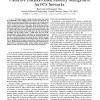Free Online Productivity Tools
i2Speak
i2Symbol
i2OCR
iTex2Img
iWeb2Print
iWeb2Shot
i2Type
iPdf2Split
iPdf2Merge
i2Bopomofo
i2Arabic
i2Style
i2Image
i2PDF
iLatex2Rtf
Sci2ools
116
click to vote
INFOCOM
1999
IEEE
1999
IEEE
Predictive Distance-Based Mobility Management for PCS Networks
This paper presents a mobile tracking scheme that exploits the predictability of user mobility patterns in wireless PCS networks. Instead of the constant velocity fluid-flow or the random-walk mobility model, a more realistic Gauss-Markov model is introduced, where a mobile's velocity is correlated in time to a various degree. Based on the Gauss-Markov model, a mobile's future location is predicted by the network based on the information gathered from the mobile's last report of location and velocity. When a call is made, the network pages the destination mobile at and around the predicted location of the mobile and in the order of descending probability until the mobile is found. A mobile shares the same prediction information with the network and reports its new location whenever it reaches some threshold distance away from the predicted location. We describe an analytical framework to evaluate the cost of mobility management for the proposed predictive distance-based ...
Communications | Gauss-Markov Model | INFOCOM 1999 | Mobile Tracking Scheme | Mobile's Future Location |
Related Content
| Added | 03 Aug 2010 |
| Updated | 03 Aug 2010 |
| Type | Conference |
| Year | 1999 |
| Where | INFOCOM |
| Authors | Ben Liang, Zygmunt J. Haas |
Comments (0)

